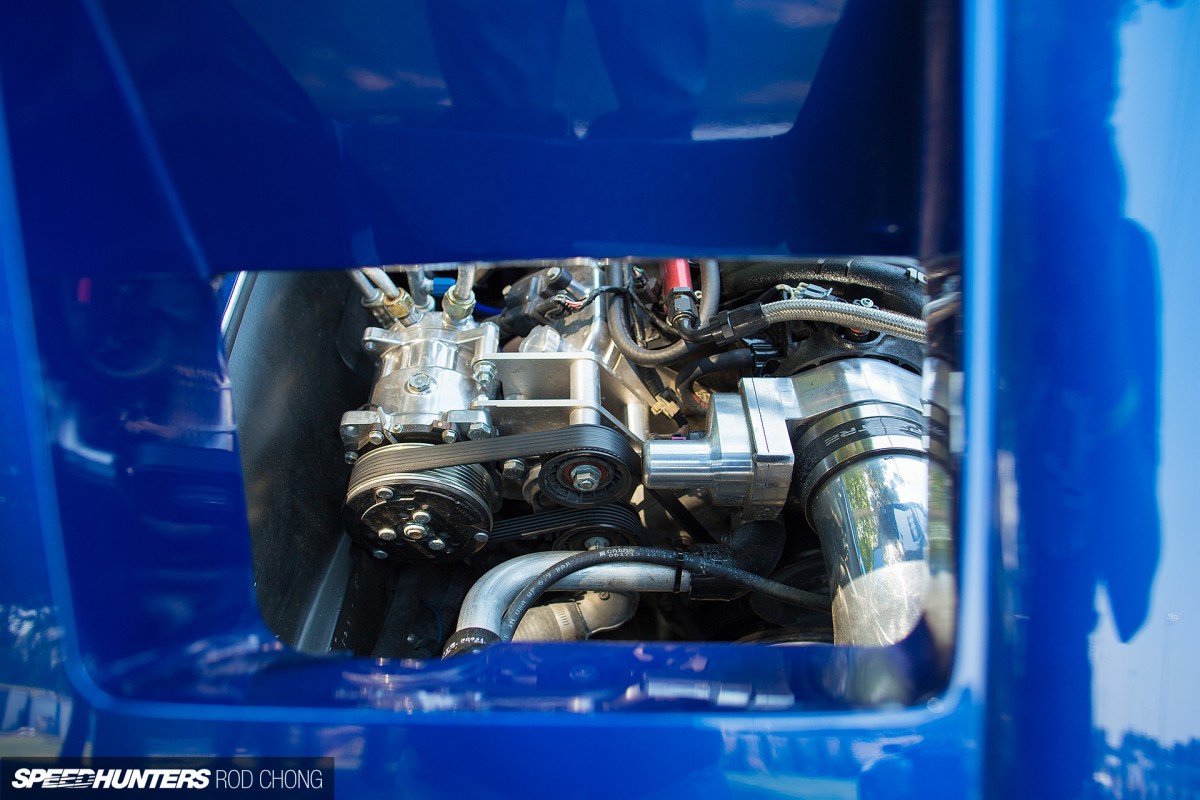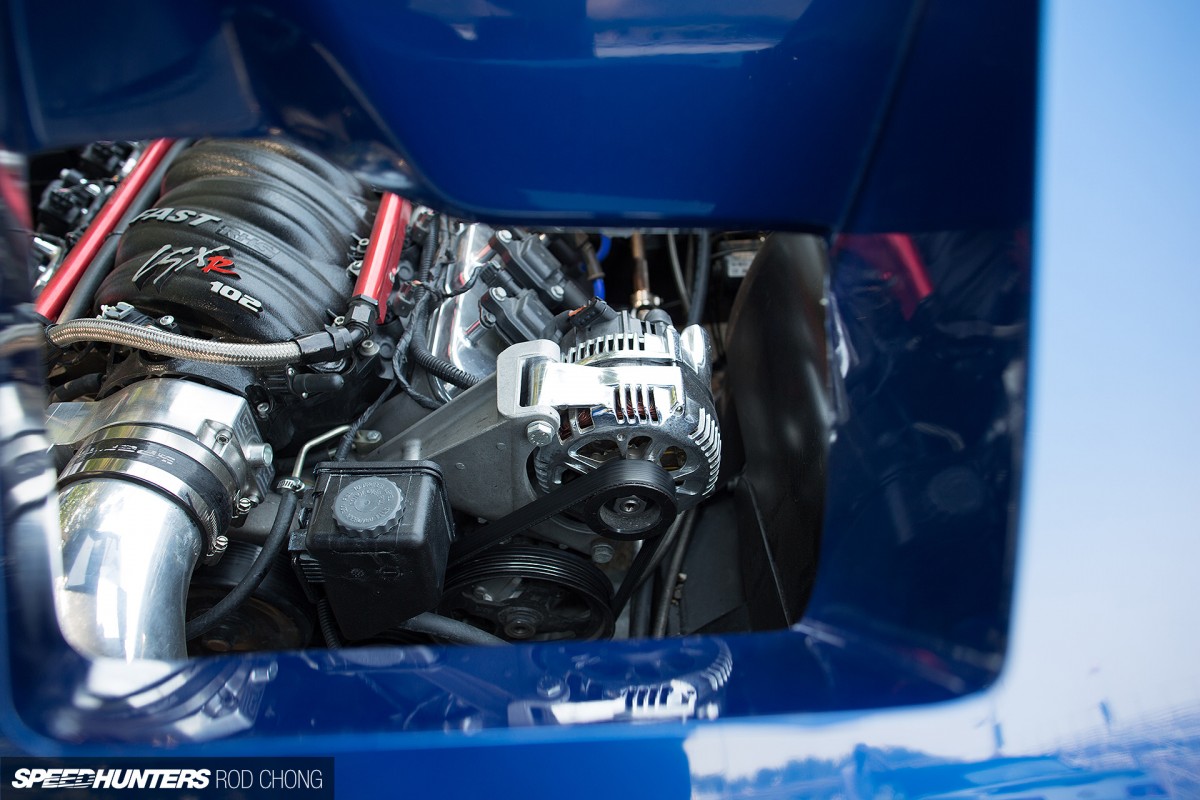
Bolting dubs on a vintage Corvette isn’t something I would normally condone. But when you see a car absolutely killing it on track you just have to stop and wonder what makes it work so well.
This is especially true when it’s something like the ’64 ‘Vette you see here, which shouldn’t be that competitive right out of the box. Not by just bolting on some rims…

So you know we had to take a closer look when we witnessed Dan Livezey’s Corvette at the recent Optima Ultimate Street Car event. This isn’t a ride out of Hotlanta. No, it’s actually quite an exquisite piece of engineering, and homebuilt to boot. And totally unlike the Big Red Corvette we featured a few weeks back.

I’ll just cut to the chase and tell you Dan’s little secret. It’s something to the effect of enough parts to build your own C6, sprinkled with some ZR1 for good measure – but we’ll get into that later.

Dan has been racing since the early ’80s and won his first Pro Solo championship in 1985. After a nice winning streak in 1989-90 he got away from racing for a while, just entering in the occasional track day for fun.

He started building the C2 you see here for the Optima Ultimate Street Car Invitational some time ago, but when it wasn’t ready in time he decided to give it a try in his old 1969 Corvette. It didn’t go so well. In fact, he describes that outing as ‘bringing a knife to a gunfight.’

So he got drastic. He sold the ’69, pulled the ’64 out of a shop that was ‘working on it’, and took matters into his own hands. This was around the time he hatched a plan to use the underpinnings from a 2010 C6 Corvette in the rebuild, figuring that would make the ’64 plenty competitive.

Obviously his plan panned out, since you can see the ‘Vette’s skeleton peeking out from under the old C2 shell. It wasn’t as easy as bolting some stuff up though. It was a series of learning experiences, sometimes devastating, and often testing the Dan’s will to finish the car.
A Not So Simple Swap
It’s a shame we can’t lift the body off like this is an R/C car, because then it would be much easier to appreciate what Dan was up against in making his idea come to life.

The devil is in the details, so I’ll attempt to explain the extensive fabrication required to make this work. That’s a complete aluminum rear suspension cradle from a C6, and the chassis was modified at a shop called Full Street so it would accept the parts. Right in the middle is a Dana 44HD center section sourced from a Dodge Viper.

Once the late model suspension cradles were installed factory control arms and spindles could be bolted in, just like a new ‘Vette. Here’s the front suspension, this time in magnesium from a 2010 model. Dan used a beefier Z06 swaybar and had a custom set of Strange four-way adjustable shocks built, then dropped the H&R coils as low as they would go.

Using the stock GM alignment cams, he’s running 2.3 degrees of camber in the front to help it stick.

Besides the obvious advantages of modern suspension geometry and a plethora of aftermarket items, the swap also enabled him to run giant carbon ZR1 brakes. Supercar stuff – on a Corvette from the ’60s!

Back to those dubs, and why I feel they’re perfectly acceptable on this ’64 Corvette. The sixth gen models came with wheels this big from the factory, measuring 19×10-inch in front and 20×12-inch in the rear. With the new suspension these steamrollers were a bolt-up, and very fitting with the factory General Motors theme Dan had going.

With all this C6 talk, you must have known an LS swap was coming, right? This one is stuffed with a combination of the best Chevy parts available, plus Comp and Lingenfelter parts to make 685 horsepower and 680 pound feet of torque.

The 427ci LS7 was pulled from, you guessed it – a 2010 Z06 Corvette. At this point I had to ask Dan if he just got a good deal on a wrecked 2010. He said that would have been the smart way to build the car, but he had in fact sourced each part separately on eBay and Corvette forums.

It turns out 2010 was just ‘the good year’ as they say, with upgrades like better bearings and a new oil cooler.

2010 also had the correct electronics to integrate ABS, something Dan did using parts from a BMW. The BMW ABS system uses the same wheel sensors as the C6 and can be reprogrammed to suit the dynamics of the car.

Air conditioning? Why not? It is called the Optima Street Car Invitational, and Dan wanted his car to be as comfortable to drive on the street as possible. He even installed power windows, door locks and a factory delay wiper system.

None of this was easy – not by any stretch of the word. Dan started down the path of using a 2010 chassis harness but couldn’t get it to work. He eventually wound up on the phone with a General Motors engineer who informed him that he would need every last module from a donor car to make it run. He didn’t want the added weight and complexity of a bunch of unused electronics, so he pulled everything out and literally lost one full year of work.
Wider Is Better
It may have occurred to you by now that a 2010 and 1964 Corvette probably don’t share the same dimensions. Clearly Dan had to widen his car, but it was more than just rolling the fenders.

The C2 is now a full eight inches wider on each side. It’s so well done that it doesn’t seem nearly that drastic though.

Dan went to great lengths to make sure the widening job didn’t disrupt the factory lines of the car. That’s quite a feat when you consider how heavily these fenders have been reworked, and especially knowing it was done at home in his garage.

He managed to get the front split bumper to fit the new widened fenders quite nicely too.

Things weren’t flowing as well in the back though, so Dan decided to set the rear bumper into the rear quarter and make a custom spoiler.

Vents were cut in the hood to let some heat out, and Buell headlights were frenched into the factory flip-up doors.

Taken together, the body mods give the car a cyborg kind of feel. Definitely unlike any other C2 you’re likely to come across.

With all the body work complete, Dan took the car to Mike Greenwood at Frank’s Auto Body in Huntington Beach for a coat of Corvette Electron Blue paint.

Once the paint fumes cleared, the only stock body panels left were the deck lid and the hardtop.

The interior is a functional space, outfitted with a full set of Auto Meter gauges, AC vents, power window switches and a simple steering wheel.

Dan’s friend Gary is a machinist, so he made a custom shift knob for fun.

Corbeau seats and harnesses keep the driver and passenger in place.

So is this a 2010 or a 1964 Corvette? Either way, it’s certainly an interesting way to build a pro-touring style car that’s competitive on track. Despite the huge amount of aftermarket parts available these days, there’s something to be said about using factory parts to complete a custom build that’s anything but.
Keith Charvonia
Instagram: SpeedhuntersKeith
keith@speedhunters.com
Photos by Rod Chong
Instagram: @speedhunters_rod
Produced by Elizabeth White
Instagram: @itswhitenoise
elizabeth@speedhunters.com

















This shit is INSANE!! Love It!!!
Awesome. Just needs a deeper front air dam to hide the 2010 subframe, which looks awkward.
Shit, I need more brakes.....
Pretty neat.
I love this car. Not at all surprised it was made by a Solo competitor. A lot of these guys really know what they're doing. Great car, I'm sure it's a blast to drive.
This is f**king cool.
Cool car--but not as quick as my Corolla at the last Hotchkis autocross. He definitely has me on the coolness quotient though. I hope to see him again in October.
I'm sure it's fast but damn do those wheels look awful.....
I don't doubt the coolness factor of it, but I just cant get over the
screwed up front suspension geometry. Setting 2.3 degree static camber is
worthless if your screwed up dynamic camber goes the other way.
@Kevin Street cars have to compromise between tire wear and on track performance. For example Miatas that are autocrossed / daily driver see around 2 degrees of negative camber where purpose built autocross cars will see 3+. It's important to remember that suspension geometry and how the arms move through a camber curve will dictate how much static camber a car requires and how much camber it gains. Tire compound and mechanical grip also play a role.
So while his static camber might "only" be 2.3 degrees, the car may gain a significant amount as it travels through it's compression phase.
Without knowing the design of his suspension and the camber gain the tire experiences through its arc of travel it's hard to evaluate the "worthiness" of his chosen numbers. Of course this is the Optima Street Car Challenge and as such a car that is driven on the street will not benefit from extreme camber angles.
But please, if you can enlighten us as to how his tire is moving under compression and dynamic load we're all ears.
Now that's what's up!
amazing, just wish he had z06 wheels on it!
I'm intrigued about you Corolla any pictures?
This thing is mental! Just imagine it with out the stickers cruising...and destroying anything that challenges it..
Lachys114 Speedhunters did a feature in 2012: http://www.speedhunters.com/2012/07/barely_lega/
More info at http://www.marksv8corolla.com/
iProGam3r Or daft punk ZR1 wheels, harder better faster stronger
modell3000 Yeah, that subframe sticks out like a sour thumb, but cool build otherwise.
The rear spoiler on this car looks miles better than those perspex monstrosities on those other C2 and Camaro featured.
I'd love to see this without all of the stickers. A phenomenal car nevertheless.
I meant the opposite of what you think meant, I meant the opposite of "only 2.3 degrees". Sorry for the misunderstanding, my English is not that good.
the lower arms are at an angle that greatly lowers the roll center of the car, thereby the roll couple is greatly increased. this is what happens to "stance" cars (but obviously this is not a "stance" car) where the increased roll couple actually causes more body roll and require even higher spring rates/ stiffer sway bars. the angle of the lower arms also contribute to "minusing" (I don't know the word for it) the camber as one side of the car compresses in a turn. what I'm saying is, even with 2.3 static camber, when the suspension compresses in a turn, the dynamic camber will reduce the degree of camber that is dialed on the car when it was stationary.
Also, don't be offended, by no means do I mean this car is "unworthy", I would kill to get to just sit in it for a lap. The angle of the lower arms is a very easily fixable problem, just look at the amount of roll centre correctors for the Silvia chassis available off the shelf. it is just a matter of spacing the lower arms so that the part where it connects to the knuckle is lower than the part where it connects to the frame. (don't know if you can understand that, sorry! haha)
Hoonigan_RB
modell3000
markstoys Very first event for car. Looking forward to the next Hotchkis Event!
Body Roll on the loaded tire reduces static negative camber settings , this cars suspension geometry produces Dynamic Camber gain (more negative camber during compressive suspension travel (about 3/4 of a degree per degree of roll)) Have made some revisions to the static camber and the roll center height since those photos. Keep in mind that it is the ball joint center (Center of the ball) and the control arm bushing centers, that it is the true angle used for determining roll center height.
EXAMPLE: 2 degrees of negative static camber + 2 degrees of body roll = 0 camber at that position, now add the dynamic camber gain at 2 degrees you have added 1.5 negative camber at that position of roll.
BTW Kevin, not an easy fix on this car to change the static control arm angles.
Looking forward to the next Hotchkis event. Car has been refined since that very first outing. Dan is an incredible workaholic and many improvements have been made since the first outing.
Frame is a custom full length frame by Street Shops in Athens, Alabama.
Wheels are certainly a personal taste, these are the factory cup package wheels, they are lighter, stronger, and validated for the extra radiant heat produced by a carbon ceramic brake package with ABS. (ABS increases brake temperatures). The USCA event (Optima) is a very challenging series to do well in all the different events. It is very demanding on brakes and this package allows for proper cooling airflow. New spoiler will also increase airflow to brakes when ducting is finished.
drd9838 Do you have any pictures of the build at all?
@drd9838 markstoys Good to hear. I've made a few tweaks as well--I'm looking forward to both of us being faster. It should be a really fun event.
@drd9838 modell3000 Better mention that the front spoiler is had made by Dan. This car turns heads anywhere it's at.
@Aaron drd9838
@Aaron drd9838 YES quite a few!
Late to this party, but I must say that this suspension from what I see is a disaster and will loose camber during compression. Car looked cool from the front end shot but was disappointed to see the full scope of it here. .
I love all of it except the wheels. That looks horrible. Way out of proportion.
Chapter 2- A cliffhanger ending of electronic nightmares. How will Dan resolve his problems?
Chapter 3- Yay fenders!
Come now, gentlemen. Continuity is key. I would have liked to know the details of how Dan managed to tame the electronics.
All the C6 harness except for engine command was eliminated, and replaced with C2 style harness
Not keen on the wheels either, to me this needs smaller alloys with some fatter sidewall tyres, and handling would benefit as a result. Of course then he'd never fit them over those brakes.
@drd9838 I know this is an old article. Where can one get more info on the abs
Thanks
@drd9838 do you have more info on the abs setup.